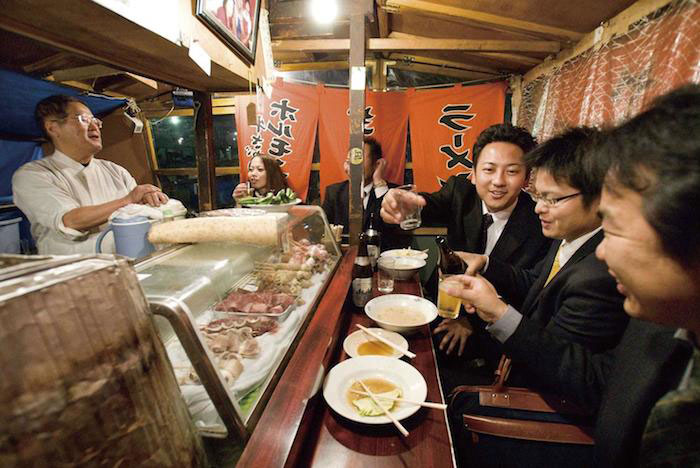Japanese Culture: Il Ramen
Ramen: “Imperatore” della tavola Giapponese.

Photo credits: narutonoodle.com/
Fino a pochi anni fa, per amanti o meno della cucina etnica, andare al Giapponese equivaleva prettamente a gustare Sushi: piatto composto da pesce crudo e riso.
Questo piatto da colori e forme suggestive strizza l’occhio ai commensali più modaioli (ma non solo!), che hanno modo di gustare “prima con gli occhi che con la gola”. Ma ora un altro piatto famoso in tutto il Giappone è finalmente approdato anche sulle nostre tavole, facendo impazzire i più.
Il Ramen (ラーメン,拉麺 rāmen), forse vero e proprio piatto rappresentativo del paese. Talmente conosciuto in tutto il Giappone che vanta per ogni regione un suo modo diverso di farlo. Regione diversa, ricetta diversa. Gustiamole tutte allora …
Una zuppa ricca di ingredienti: spaghetti cinesi, carne di maiale, Nori (海苔) o alga secca, uova sode, e il kamaboko. Da noi conosciuto come surimi, la sua forma più famosa, quella a spirale, si chiama Naruto (come il personaggio del manga omonimo il cui nome è ispirato proprio a questo ingrediente) . Il brodo può essere di pesce o carne, varie guarnizioni e modi diversi di insaporire, con semi di sesamo o pepe, dal miso alla salsa di soia.
Storia di una Zuppa

Photo credits: travelcaffeine.com
Benché non sia chiaro quando ebbe inizio la diffusione di questo piatto in suolo giapponese, l’origine è cinese, visto che uno degli ingredienti base sono i mian o spaghetti cinesi di frumento. Va anche detto che in Cina solo negli ultimi anni c’è stata una riscoperta, non considerato più piatto tradizionale ma d’importazione giapponese. In Cina vengono chiamati rìshì lāmiàn “Lamian in stile Giapponese”.
Il Ramen è sempre stato un piatto da gustare fuori casa, e all’inizio del ‘900 c’erano numerosi chioschi da strada con gestori Cinesi. Poi, dopo la Seconda Guerra Mondiale, i soldati giapponesi di rientro dalla Cina, dove avevano appreso la tradizione culinaria, aprirono diversi ristoranti in tutto il paese. Da lì in poi, una continua evoluzione che ha portato a come si conosce il Ramen oggi giorno.
Così tanto amato che dal 1994 è stato aperto a Yokohama lo Shin-Yokohama Raumen Museum il museo interamente dedicato a questa prelibatezza.
Ramen da compagnia.

Photo credits: jpninfo.com
Come detto in precedenza, in passato non era poi così strano gustare scodelle di Ramen nei chioschi da strada, famosi anche oggi giorno sebbene non diffusissimi. Questo perché il Ramen è anche un cibo da strada da assaporare nei tradizionali Yatai, bancarelle mobili. I migliori ristoranti invece sono i Ramen-ya con pochi posti a sedere sia al banco che ai tavoli, ma con la finalità di mangiare solo Ramen.
E non è inusuale trovare piatti di Ramen in parchi divertimento o nei menù dei karaoke. Ci scappa anche che finito il lavoro tra colleghi si faccia un salto agli Izakaya, pub con la formula Nomihodai “all you can drink” e Tabehodai “all you can eat”. Qui, con un tempo massimo di tre ore, i commensali tra liquori ed altri cibi possono gustare anche il Ramen con un menù dal prezzo fisso.
Menzioni d’onore e le regionali.

Photo credits: zerochan.net
Benché la ricetta classica sia comune in tutto il Giappone ci sono varianti sempre innovative.
Qui va menzionato il Ramen Blue , di un bellissimo e brillantissimo colore, e vogliamo anche dirlo del tutto naturale! Ma questa è un’innovazione estrema.
Le varianti “classiche” regionali sono:
- Quella di Tokyo con tagliatelle spesse in brodo di pollo al gusto soia, con guarnizione di germogli di bamboo, scalogno, maiale a fette, spinaci alghe, un uovo e un po’ di Dashi. Da provare nei quartieri di Ikebukuro, Ogikubo e Ebisu.
- A Sapporo è famosa per la versione “invernale”, con talvolta frutti di mare, burro, maiale, mais e germogli di fagioli.
- Yokohama ha il le-kei , uovo alla coque dove il commensale deve indicare la morbidezza desiderata per poi romperlo ed insaporire il brodo con cipolla, maiale, spinaci e alga.
- Kitakata con tagliatelle spesse ma piatte, servite in brodo di maiale.
- Hakata con brodo composto da osso di maiale, e con spaghetti sottili, zenzero, aglio, verdure in senape e semi di sesamo.
Se leggendo questo articolo vi è venuta una gran fame vogliamo lasciarvi alcuni indirizzi dove poterlo gustare qui in Italia:
Nozomi
Via Pietro Calvi 2, 20129 Milano, Italia
+39 02 7602 3197
http://www.nozomi.milano.it/
Casa Ramen
Via Porro Lambertenghi 25, Milano, Italia
+39 02 3944 4560
https://www.facebook.com/casaramen
Zarà Ramen
Via Solferino, 48, 20121 Milano, Italia
+39 02 3679 9000
https://www.facebook.com/zazaramen/
Mi-Ramen Bistro
Viale col di lana, 15 | Viale Col Di Lana, 15, 20136, Milano
+39 339 232 2656
http://mi-ramenbistro.it/
Osaka
Corso Giuseppe Garibaldi 68, 20121 Milano, Italia
+39 02 2906 0678
http://www.milanoosaka.com/
Ryukishin
Via Ariberto 1, 20123 Milano, Italia
+39 02 8940 8866
http://www.ryukishin.it/
Banki Ramen
Via Dei Banchi 14 Rosso, 50123, Firenze, Italia
+39 055 213776
Waraku
Via Prenestina 321/A, 00177 Roma, Italia
+39 06 2170 2358
https://www.facebook.com/Waraku-192626757583758/
Condividi:
- Fai clic per condividere su Facebook (Si apre in una nuova finestra)
- Fai clic qui per condividere su Twitter (Si apre in una nuova finestra)
- Fai clic qui per condividere su Tumblr (Si apre in una nuova finestra)
- Fai clic qui per condividere su Pinterest (Si apre in una nuova finestra)
- Fai clic per condividere su Telegram (Si apre in una nuova finestra)
- Fai clic per condividere su WhatsApp (Si apre in una nuova finestra)
- Fai clic qui per condividere su Reddit (Si apre in una nuova finestra)
- Fai clic qui per stampare (Si apre in una nuova finestra)






